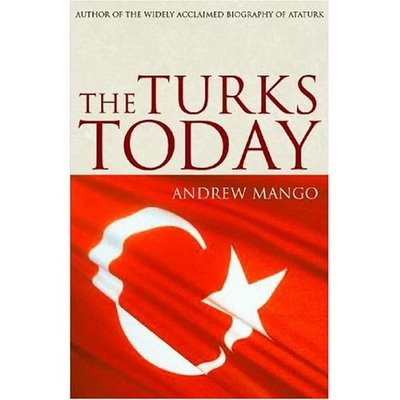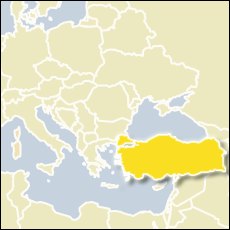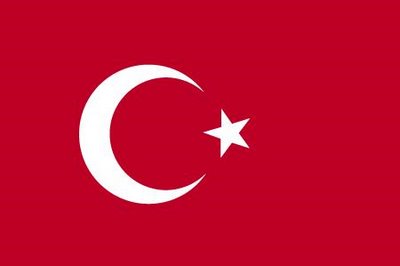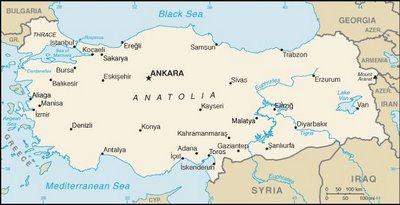Who is Andrew Mango?
Andrew Mango (born 1926) is a British author who was born in Istanbul, Turkey, one of three sons of a prosperous Anglo-Russian family. He is the brother of the distinguished Oxford historian and Byzantinist, Professor Cyril Mango. Mango's early years were passed in Istanbul but in the mid-1940's he left for Istanbul and a job as a press officer in the British Embassy. He moved to the United Kingdom in 1947 and has lived in London ever since. He holds degrees from London University, including a doctorate on Persian literature. He joined BBC's Turkish section while still a student and spent his entire career in the External Services, rising to be Turkish Programme Organiser and then Head of the South European Service. He retired in 1986.

About the book "The Turks Today" by Andrew Mango
From The Washington Post's Book World/washingtonpost.com
If countries could be vegetables, Turkey would be an onion. Every time you take off a layer of skin, hoping to get to the core, you come across yet another skin. In The Turks Today, Andrew Mango successfully peels modern Turkey to its core.
Most people who have rubbed elbows with Turks might suggest that they are experiencing an identity crisis, torn between the East and the West. In contrast, Mango, who was born in Istanbul, says the Turks have a strong sense of national identity. The Turks are "a distinct people with a Muslim background," he writes, who think like the West more so "than do their Muslim neighbors to the east and south." In the post-Sept. 11 world, Turkey indeed stands out. To what does the country owe its uniqueness?
Turkey's position between Europe and the Middle East is a major factor. However, Kemal Ataturk's legacy of secular democracy in a Muslim society is even more important.
Clearly, Ataturk was a visionary politician, but why has Turkey managed to remain a secular democracy more than 60 years after his death? Why has it not fallen like Iran's pro-Western regime, which collapsed like a house of cards in 1979, or declined like Egypt, an intellectual powerhouse in the 1930s that is now a crumbling edifice? Well, Ataturk got it right. He made Turkey a secular republic in the 1920s, long before it became a democracy in 1950. Hence, even after Ataturk's own Republican People's Party (CHP) lost Turkey's first free multiparty elections in 1950, secularism was able to survive. Not only that, it was now armed with democracy to defend itself. For example, when members of the Muslim Ticani order started mutilating Ataturk's statues in 1951 and attacking secularism, the Democrat Party, which had just defeated the CHP, passed a law to protect Ataturk's legacy.
And more recently, when the Turkish military challenged the Islamist Welfare Party government in 1997, it found many allies within the country, ranging from secular political parties and media to NGOs and women's groups. Women's participation in the anti-Islamist alliance was not an accident. Turkish women are "much more emancipated and better able to realize their potential" than women in other Muslim countries, Mango writes.
The second reason why Turkey works is the Alevis. Little known outside the country, Alevis are liberal Muslims who profess a syncretic version of Islam laden with elements of Sufism and Shamanism, the Turks' pre-Islamic faith. Alevis shun fundamentalism and cherish secularism. According to Mango, they represent a "distinctively Turkish humanist Islam open to modernity."
While planting the seeds of secular democracy, Ataturk found inspiration in 19th-century French and European sociology. Therefore, contemporary Turkey shares many similarities with France, including administrative practices and legal structures. Along the same line, secularism in Turkey, like the French concept of laicité, provides freedom from religion.
Just as Turkey learned from Europe in the past, that continent, grappling with a growing and restless Muslim community, can now turn to Turkey for ideas. Turkish secularism has created a tradition of "state Islam" whereby the government builds and staffs mosques to curb the influence of jihadist preachers. Meanwhile, Turkish Islam "has learnt to live in a secular state in a society where secular values prevail," Mango writes. Turkey has much to offer France and the European Union.
Even so, Turkey's path to the E.U. is full of uncertainties. Although Ankara, which applied to join in 1987, was recently invited to start accession talks in October 2005, resistance to Turkey's membership is rife in Europe -- ironically, especially in France. Most Europeans say, for instance, that Ankara's human- rights record is too negative. "Turkish citizens are at least as free as their neighbours in the Balkans," Mango contends. Other critics say that Ankara is too poor for Brussels. Turkey surely has catching up to do with Europe. It needs to improve its economy and reform its heavily centralized, inefficient government, which Mango sees as a drain.
All the same, Turkey is a southern European country. Like Greece and Spain, it has a history of military involvement in politics; like Portugal's, its economy is dominated by large family-owned conglomerates; and like Italy, it possesses an intricate network of social structures.
For the Turks, joining the E.U. is not about entering Europe; it is about going back to Europe. Almost half of them are of European descent, ranging from Hungarian Muslims and Bosnians to Greek Muslims and Balkan Turks, who have been driven out of the continent ever since the territorial demise of the Ottoman Empire started in the late 17th century. Even in its worst days in the 19th century, Turkey was known as the "sick man of Europe," not the sick man of the Middle East. The Turks might well be ready for Europe; the Europeans, though, do not seem ready to take them into their midst. As Andrew Mango makes clear, modern Turkey is not an oddity; it is, however, a rare kind of nation that deserves special attention.
Andrew Mango: Armenians made a legend of the so-called 'Armenian genocide'
ACCORDING TO ENGLISH HISTORIAN, ARMENIA TRY TO DRAW ATTENTION OF THE WORLD COMMUNITY TO 'GENOCIDE' TO HIDE THEIR CRIMES COMMITTED IN AZERBAIJAN!
English historian, Prof. Andrew Mango has made an interesting statement in connection with the so-called ' Armenian genocide'. Touching upon the tendency on actualization of the 'Armenian genocide' Mango said that something different is hidden behind such tendencies. The Armenians put forward the issue of Armenian genocide to hide their crimes committee in Azerbaijan over the past period. "They have made a legend of the so-called genocide. Anything about the genocide is out of question. The situation was very tough during World War II. Both sides gave definite losses. If there were a genocide act against the Armenians, then there would not be such number of Armenians in Libya, Syria, France and Armenia. They urge 600,000 Armenians were killed in that period while fighting for lands. Now they increased the figure to 1.5 million. The World should understand what does it mean, " he writes. According to Mango, the historians should be involved in study of historical problems. It would be wrong to politicize the historical events. The worst is that they distract from the debates with the scientists on this issue. They are involved in making 'fictions'.
The Armenians refer to 'Blue Book' as an evidence to the so-called 'genocide'. Mango, however, noted the book was not written on the unbiased data. "The book was prepared and publicized by the British government during the World War I as a mean of propaganda. Arnold Tornby, one of the authors of the books, even later confessed the book did not reflect the truth, as it regarded the Armenian issue unilaterally. So, no historian regards the books as a significant source." Mango underlines that the book was prepared o the base of materials provided by the Armenian to the US Consulate. The book does not contain any data by the Turks. So, it would be unfair to accept a book written only on the base of Armenian materials as a truth.
Regarding the Turkish parliament's will to send a letter to British parliament in this connection, Mango said it would be hardly effective. "They could not only issue a statement on connection with 'Blue Book'.
Resource: azerilife.blogspot.com/2005/07/andrew-mango-armenians-made-legend-of.html









